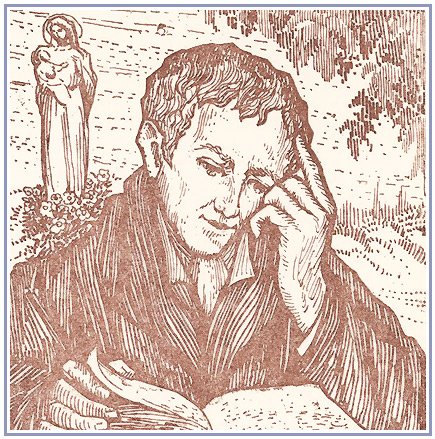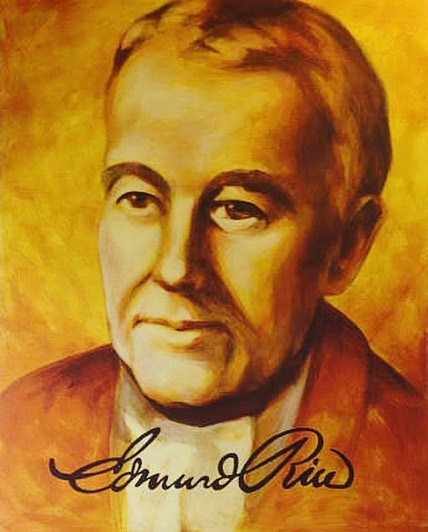Two Significant Letters from Edmund by Frank Keane
- Details
- Hits: 15205
On letters Edmund wrote to The Archbishop of Cashel and to Mr Bryan Bolger
- the Archbishop of Cashel and Mr Bryan Bolger, 9 May 1910
- to Mr Bryan Bolger, Architect, 10 August 1810
The first decade of the 21st century has provided us with several significant anniversaries in the life of Edmund Rice. 1802 saw the first school in New Street. In 1803 the monastery at Mount Sion was occupied. The following year the schools at Mount Sion were ready. In 1805 the Presentation Rule was approved by the Pope. That same year the Brothers’ school in Carrick-on-Suir was opened. Dungarvan was opened the following year. Michael Power and James Mulcahy joined the society in 1807. The Brothers made profession of vows for one year in 1808. In 1809 these vows were taken for life. 1810 has special significance. The first novices came from Cork to make their novitiate in Waterford. Besides, two notable letters were written by Edmund that year. Firstly the oldest extant letter of Edmund (that we know of): its great value is that it contains a very accurate and detailed description of the school system developed by the Founder for Mount Sion. Secondly a letter to Bryan Bolger: this is particularly valuable as it contains some of the most revealing of Edmund’s ‘quotable quotes’.
The letter to the Archbishop contains an ‘enclosure’ outlining ‘regulations of our schools’. The detail in the descriptions is remarkable. One is impressed with the subtle differences obtaining in the upper and lower ‘schools’. Even the furniture is different. The older boys sat at double desks, 12 on each; the younger boys used single desks, 7 on each. Obviously the younger children needed more personal attention. In the Presentation Rule (Part 1: Chapter 1, Article 2) then applying, the Brothers were instructed to ensure to adapt “their language to the age and capacity of the children”.
 We are impressed with the efficient use of time. There was a clock in each room “the better to direct them in the regulating the time”. Group teaching was the order of the day: “Whilst one class reads and hears instruction, the other desks are employed at sums, etc.” If time was efficiently regulated, so also was the energy of the Brother. With in excess of 100 pupils, how could he possibly attend to the myriad activities taking place simultaneously? The system devised by Joseph Lancaster and Andrew Bell was adapted. Older boys, referred to as monitors, prepared the work, examined the children, and when necessary, referred individual boys to the Brother in charge. As Edmund wrote, “Over each desk a monitor or superintendent is appointed, who keeps an account of the conduct of those committed to his care.” During the reading lessons the opportunity was availed of to provide “familiar moral instruction”.
We are impressed with the efficient use of time. There was a clock in each room “the better to direct them in the regulating the time”. Group teaching was the order of the day: “Whilst one class reads and hears instruction, the other desks are employed at sums, etc.” If time was efficiently regulated, so also was the energy of the Brother. With in excess of 100 pupils, how could he possibly attend to the myriad activities taking place simultaneously? The system devised by Joseph Lancaster and Andrew Bell was adapted. Older boys, referred to as monitors, prepared the work, examined the children, and when necessary, referred individual boys to the Brother in charge. As Edmund wrote, “Over each desk a monitor or superintendent is appointed, who keeps an account of the conduct of those committed to his care.” During the reading lessons the opportunity was availed of to provide “familiar moral instruction”.
School began in the morning at nine o’clock when the business of the day “immediately commences”. For the next two and a half hours Brothers, monitors, and pupils followed a familiar and useful routine. Then at eleven thirty “the bell rings for giving general religious instruction…suited to the capacity of the children”. At twelve o’clock the Angelus and different devotional prayers were recited. The children were then sent home.
The afternoon session, commencing at one o’clock, followed a programme similar to that in the morning. The day’s work concluded with the recitation of the Litany of the Blessed Virgin and other prayers. At three o’clock the school closed for the day, or as the Presentation Rule quaintly stipulated the “school [shall be] broken up”
We note that the efficient use of time guaranteed maximum benefit to the pupils. The school had both a clock and a bell. We are familiar with the custom of reciting the Hail Mary each time the clock struck the hour. Details were given of how the slates should be lined. The regular general examinations, the availability of a school library, where “we seldom lose a book”, the quarterly provision of a Confessor, the spiritual care of apprentices who were encouraged to attend the Sacraments once a month, show us a highly organised, orderly, and well-developed system. Edmund’s focus was not confined to the pupils. They brought books home and read them to their parents, who, in all likelihood, were illiterate. The psychology used here has to be admired. Parents, seeing their own sons capable of reading, would give them every encouragement to remain in school. Secondly, they themselves would benefit from the lessons taught to them by their sons, “when they can do it with prudence”.
In reading Edmund’s description we detect a deep interest in each of the pupils. Individual attention ensured that each boy continued to make progress. In the covering letter, Edmund stated that teaching the Catechism was, firstly, the most salutary part of the system, and secondly, the most laborious to the teachers, but “if it was ten times what it is, I must own we are amply paid in seeing the Reformation in the Children”.
Eight years’ experience had refined Edmund’s system of education. Twenty years later we note that this well-tried system obtained in all the Brothers schools. There is a strong note of confidence in Edmund’s description. Obviously pleased with the success, and knowing “the harvest is great, and the labourers few”, Edmund showed both prudence and zeal in establishing new schools. However, he was not content just to sit back. His prayer for the Institute was that “it will spread before long in most parts of the Kingdom”.
Bryan Bolger played an important part is the growth of the Institute, especially in Dublin. While the 1810 letter deals with serious business matters, Edmund shows such familiarity with Bryan that he can freely reveal his inner emotions and feelings. We read: “it’s a poor thing, I must own, to be expecting reward of labour from creatures who frequently are forgetful and ungrateful for favours done them.” He continued, “but let us do ever so little for God we will be sure he will never forget it, nor let it pass unrewarded.” Later referring to “mountains of difficulties” in dealing with anything to do with Charitable purposes, he remarks: “but one thing you may be sure of, that whilst you work for God, whether you succeed or not, he well amply reward you.” The letter concludes with reference to the Back Lane property at Mount Sion. While dealing with a serious legal and financial situation, Edmund showed his usual detachment, being “easy about it”. However, his now familiar prayer is added, “The Will of God be done in this and everything we undertake.”
 It is now two centuries since Edmund penned the above letters. Their message, however, is as relevant today as it was 200 years ago. Firstly, as Brothers, are we convinced of the importance of our Congregation’s commitment to education? Do we see the utter importance of instructing children in their duties to God and to their neighbour? While wonderful advances have been made in educational developments, Edmund’s blueprint is as relevant today as it was in 1810. Our Congregation has spread not only to “most parts of the Kingdom” but to the five continents. In our successes do we feel undervalued by those “creatures who frequently are forgetful and ungrateful for favours done them”? In your moments of failure do you remember, if we succeed or not, God ‘will amply reward you’? In recent years our Congregation has suffered serious and humiliating revelations. Do we lose confidence? Conscious of unwelcome developments, do we pray that “The Will of God be done in this and everything we undertake”?
It is now two centuries since Edmund penned the above letters. Their message, however, is as relevant today as it was 200 years ago. Firstly, as Brothers, are we convinced of the importance of our Congregation’s commitment to education? Do we see the utter importance of instructing children in their duties to God and to their neighbour? While wonderful advances have been made in educational developments, Edmund’s blueprint is as relevant today as it was in 1810. Our Congregation has spread not only to “most parts of the Kingdom” but to the five continents. In our successes do we feel undervalued by those “creatures who frequently are forgetful and ungrateful for favours done them”? In your moments of failure do you remember, if we succeed or not, God ‘will amply reward you’? In recent years our Congregation has suffered serious and humiliating revelations. Do we lose confidence? Conscious of unwelcome developments, do we pray that “The Will of God be done in this and everything we undertake”?
Frank Keane cfc
The full text of both letters can be found in ‘A Companion to as Tree is Planted,’ pages 1 to 8. An extensive list of Edmund’s ‘quotable quotes’ can be found on this website under EDMUND RICE/ABOUT EDMUND/ EDMUND QUOTED.







